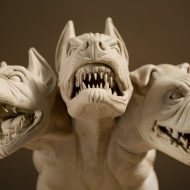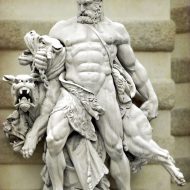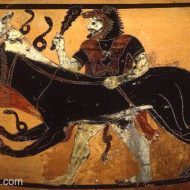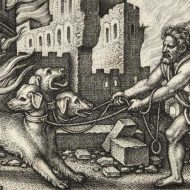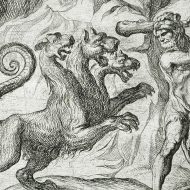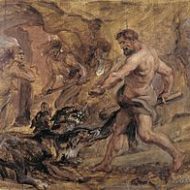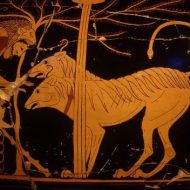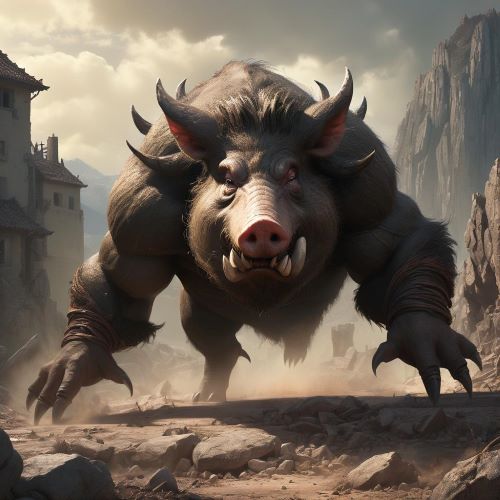Cerberus : The Hell Hound
Listen
At a glance
| Description | |
|---|---|
| Origin | Greek Mythology |
| Classification | Animals |
| Family Members | Typhon (Father), Echidna (Mother), Chimera, Hydra (Sister), Orthus (Brother) |
| Region | Greece |
| Associated With | Underworld, Hades |
Cerberus
Introduction
In Greek mythology, Cerberus is a monster that lives in the underworld. He was often described as having three heads, but Hesiod, who was a 7th century BCE poet, said that he had 50. He devoured people who tried to escape Hades, the god of the underworld, and he would not let anyone enter his kingdom. Orpheus, a mythological hero, was able to pass through by charming him with music. Heracles was tasked with bringing the beast known as Cerberus to the realm of the living. After successfully doing so, he sent the creature back to Hades.
Physical Traits
Various sources have provided contradicting accounts of the appearance of Cerberus. Hesiod, for instance, claimed that he had 50 heads. Others, such as Pindar, who lived during the 5th century BCE, gave him hundreds of heads. Most later sources only described him in terms of three heads. Horace, a Roman poet, also gave the beast a single head with a pair of tongues and a large snake tail.
Byzantine scholar and poet John Tzetzes tried to reconcile the conflicting accounts by giving the beast 50 heads, which included the heads of various animals. Although Cerberus was usually only represented with one body, according to Virgil and Euripides, he had multiple bodies.
Family
Greek mythology shows that Cerberus had nine siblings. His parents are Echidna, who is a half-serpent creature, and Typhon, who is a fire-breathing giant. There are also multiple multi-headed monsters such as the Chimaera and the Hydra. He is the brother of Orthrus and the father of the Nemean lion and the Sphinx.
Cerberus had connections with Egyptian mythology is also one of the Eye of Ra’s manifestations, a powerful force that can either protect or destroy. He was linked to various goddesses, such as Sekhmet, Wadjet, and Hathor. He was also associated with an Egyptian god known as Anubis, who was known as the god of mummification.
Other names
It is uncertain how the name Cerberus came to be. Some believe it originated from the Greek word kreboros, which literally means “flesh-devouring.” The use of the name Cerberus in Indo-European etymologies has been met with skepticism. It is believed that the origin of the name is pre-Greek.
Although scholars generally dismiss the etymology of the name, they do agree that it came from a European root that means “to growl.” It is also believed that the link between the name and Garmr, which is a guard dog in Norse mythology, was established by the Proto-Indo European root “ger-.”
Powers and Abilities
Hades, the god of the dead, assigned Cerberus to guard the gates of the underworld. Rather than preventing people from coming in, like most guard dogs, Cerberus’ job was to ensure that nobody left. It was believed that he was capable of more than just having a taste for raw flesh. According to some sources, he was able to flash fire, have an unparalleled hearing, and consume venom.
Modern Day Influence
The Heracles myth is frequently adapted into popular culture in modern times including the stories involving Cerberus, with the notable example being Disney’s 1997 film Hercules. In the same year, the franchise’s TV series, Hercules: The Legend of Hercules, introduced a more realistic version of the beast. In the video game, Final Fantasy VIII, Cerberus serves as a “summon” that can be summoned by the hero. In 1997, a similarly large and powerful dog named Fluffy was modeled after the beast in J. K Rowling’s Harry Potter and Philosopher’s Stone.
Related Images
Frequently Asked Questions
What God killed Cerberus?
Though not slain by a god, Cerberus’ fate hinges on venturing beyond the underworld. Heracles’ capture exposes him to daylight, causing his potential death, while Orpheus’ enchanting music offers temporary passage, highlighting the consequences and challenges of breaching Hades’ domain.
Is a Cerberus evil?
Cerberus, underworld guardian, isn’t evil, but duty-bound. His fearsome form and loyalty to Hades ensure the dead stay dead, not out of malice, but as protector of a natural order. Though swayed by music, he stands firm, not evil, but a formidable barrier between worlds.
Why Cerberus has 3 heads?
They symbolize Cerberus’ constant watchfulness, some say the past, present, and future, others a link to death’s mysteries, or simply amp up his monstrous dread. Whatever the reason, they solidify him as the ultimate, terrifying gatekeeper of the underworld.
Why is Cerberus scary?
Cerberus’ scariness is a three-headed hydra of fear: multiple gnashing maws, guardian of Hades’ mysteries, monstrous form, relentless duty, and centuries of chilling tales. He’s not just a dog, he’s a nightmare made flesh, guarding the ultimate unknown.
Is Cerberus loyal to Hades?
A three-headed hound, he lives to serve, fiercely guarding the underworld with unwavering duty, his multiple heads symbolizing eternal vigilance. Not just a pet, but an extension of Hades, Cerberus exemplifies loyalty at its most devoted and chilling.

